Shi Li
SUNY at Buffalo
A Unified Graph-based Framework for Scalable 3D Tree Reconstruction and Non-Destructive Biomass Estimation from Point Clouds
Jun 18, 2025Abstract:Estimating forest above-ground biomass (AGB) is crucial for assessing carbon storage and supporting sustainable forest management. Quantitative Structural Model (QSM) offers a non-destructive approach to AGB estimation through 3D tree structural reconstruction. However, current QSM methods face significant limitations, as they are primarily designed for individual trees,depend on high-quality point cloud data from terrestrial laser scanning (TLS), and also require multiple pre-processing steps that hinder scalability and practical deployment. This study presents a novel unified framework that enables end-to-end processing of large-scale point clouds using an innovative graph-based pipeline. The proposed approach seamlessly integrates tree segmentation,leaf-wood separation and 3D skeletal reconstruction through dedicated graph operations including pathing and abstracting for tree topology reasoning. Comprehensive validation was conducted on datasets with varying leaf conditions (leaf-on and leaf-off), spatial scales (tree- and plot-level), and data sources (TLS and UAV-based laser scanning, ULS). Experimental results demonstrate strong performance under challenging conditions, particularly in leaf-on scenarios (~20% relative error) and low-density ULS datasets with partial coverage (~30% relative error). These findings indicate that the proposed framework provides a robust and scalable solution for large-scale, non-destructive AGB estimation. It significantly reduces dependency on specialized pre-processing tools and establishes ULS as a viable alternative to TLS. To our knowledge, this is the first method capable of enabling seamless, end-to-end 3D tree reconstruction at operational scales. This advancement substantially improves the feasibility of QSM-based AGB estimation, paving the way for broader applications in forest inventory and climate change research.
Temporal Entailment Pretraining for Clinical Language Models over EHR Data
Apr 25, 2025Abstract:Clinical language models have achieved strong performance on downstream tasks by pretraining on domain specific corpora such as discharge summaries and medical notes. However, most approaches treat the electronic health record as a static document, neglecting the temporally-evolving and causally entwined nature of patient trajectories. In this paper, we introduce a novel temporal entailment pretraining objective for language models in the clinical domain. Our method formulates EHR segments as temporally ordered sentence pairs and trains the model to determine whether a later state is entailed by, contradictory to, or neutral with respect to an earlier state. Through this temporally structured pretraining task, models learn to perform latent clinical reasoning over time, improving their ability to generalize across forecasting and diagnosis tasks. We pretrain on a large corpus derived from MIMIC IV and demonstrate state of the art results on temporal clinical QA, early warning prediction, and disease progression modeling.
ChronoFormer: Time-Aware Transformer Architectures for Structured Clinical Event Modeling
Apr 10, 2025Abstract:The temporal complexity of electronic health record (EHR) data presents significant challenges for predicting clinical outcomes using machine learning. This paper proposes ChronoFormer, an innovative transformer based architecture specifically designed to encode and leverage temporal dependencies in longitudinal patient data. ChronoFormer integrates temporal embeddings, hierarchical attention mechanisms, and domain specific masking techniques. Extensive experiments conducted on three benchmark tasks mortality prediction, readmission prediction, and long term comorbidity onset demonstrate substantial improvements over current state of the art methods. Furthermore, detailed analyses of attention patterns underscore ChronoFormer's capability to capture clinically meaningful long range temporal relationships.
Exploring Neural Ordinary Differential Equations as Interpretable Healthcare classifiers
Mar 05, 2025Abstract:Deep Learning has emerged as one of the most significant innovations in machine learning. However, a notable limitation of this field lies in the ``black box" decision-making processes, which have led to skepticism within groups like healthcare and scientific communities regarding its applicability. In response, this study introduces a interpretable approach using Neural Ordinary Differential Equations (NODEs), a category of neural network models that exploit the dynamics of differential equations for representation learning. Leveraging their foundation in differential equations, we illustrate the capability of these models to continuously process textual data, marking the first such model of its kind, and thereby proposing a promising direction for future research in this domain. The primary objective of this research is to propose a novel architecture for groups like healthcare that require the predictive capabilities of deep learning while emphasizing the importance of model transparency demonstrated in NODEs.
Advanced Equalization in 112 Gb/s Upstream PON Using a Novel Fourier Convolution-based Network
May 04, 2024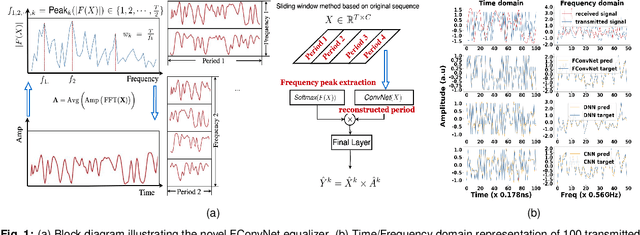


Abstract:We experimentally demonstrate a novel, low-complexity Fourier Convolution-based Network (FConvNet) based equalizer for 112 Gb/s upstream PAM4-PON. At a BER of 0.005, FConvNet enhances the receiver sensitivity by 2 and 1 dB compared to a 51-tap Sato equalizer and benchmark machine learning algorithms respectively.
Machine Learning in Short-Reach Optical Systems: A Comprehensive Survey
May 02, 2024
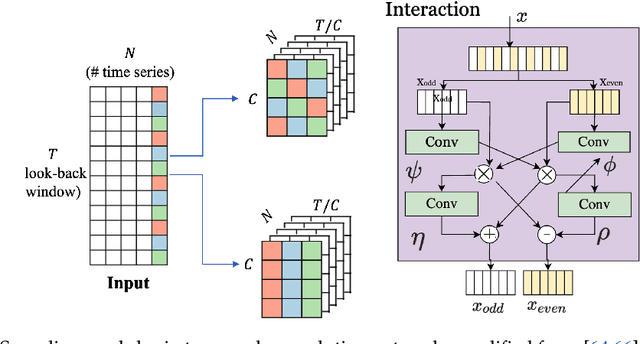

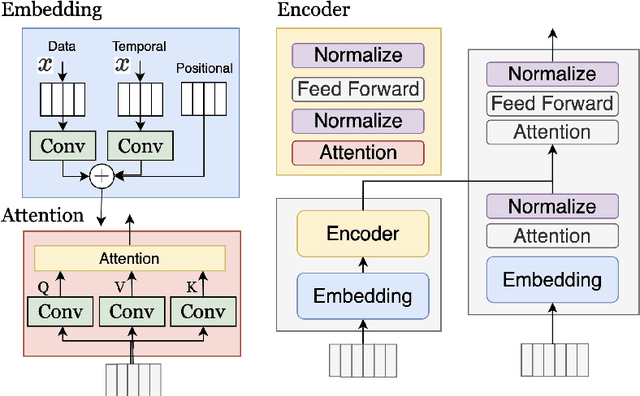
Abstract:In recent years, extensive research has been conducted to explore the utilization of machine learning algorithms in various direct-detected and self-coherent short-reach communication applications. These applications encompass a wide range of tasks, including bandwidth request prediction, signal quality monitoring, fault detection, traffic prediction, and digital signal processing (DSP)-based equalization. As a versatile approach, machine learning demonstrates the ability to address stochastic phenomena in optical systems networks where deterministic methods may fall short. However, when it comes to DSP equalization algorithms, their performance improvements are often marginal, and their complexity is prohibitively high, especially in cost-sensitive short-reach communications scenarios such as passive optical networks (PONs). They excel in capturing temporal dependencies, handling irregular or nonlinear patterns effectively, and accommodating variable time intervals. Within this extensive survey, we outline the application of machine learning techniques in short-reach communications, specifically emphasizing their utilization in high-bandwidth demanding PONs. Notably, we introduce a novel taxonomy for time-series methods employed in machine learning signal processing, providing a structured classification framework. Our taxonomy categorizes current time series methods into four distinct groups: traditional methods, Fourier convolution-based methods, transformer-based models, and time-series convolutional networks. Finally, we highlight prospective research directions within this rapidly evolving field and outline specific solutions to mitigate the complexity associated with hardware implementations. We aim to pave the way for more practical and efficient deployment of machine learning approaches in short-reach optical communication systems by addressing complexity concerns.
A Novel Machine Learning-based Equalizer for a Downstream 100G PAM-4 PON
Apr 25, 2024


Abstract:A frequency-calibrated SCINet (FC-SCINet) equalizer is proposed for down-stream 100G PON with 28.7 dB path loss. At 5 km, FC-SCINet improves the BER by 88.87% compared to FFE and a 3-layer DNN with 10.57% lower complexity.
KIGLIS: Smart Networks for Smart Cities
Jun 09, 2021
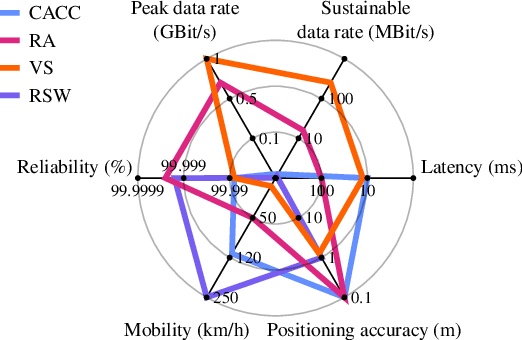
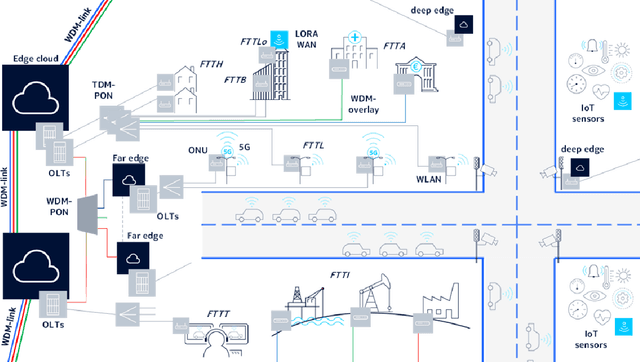
Abstract:Smart cities will be characterized by a variety of intelligent and networked services, each with specific requirements for the underlying network infrastructure. While smart city architectures and services have been studied extensively, little attention has been paid to the network technology. The KIGLIS research project, consisting of a consortium of companies, universities and research institutions, focuses on artificial intelligence for optimizing fiber-optic networks of a smart city, with a special focus on future mobility applications, such as automated driving. In this paper, we present early results on our process of collecting smart city requirements for communication networks, which will lead towards reference infrastructure and architecture solutions. Finally, we suggest directions in which artificial intelligence will improve smart city networks.
56 GBaud PAM-4 100 km Transmission System with Photonic Processing Schemes
May 17, 2021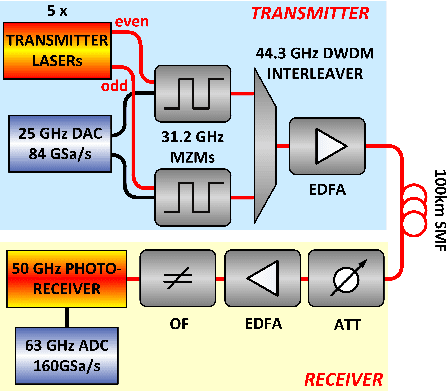
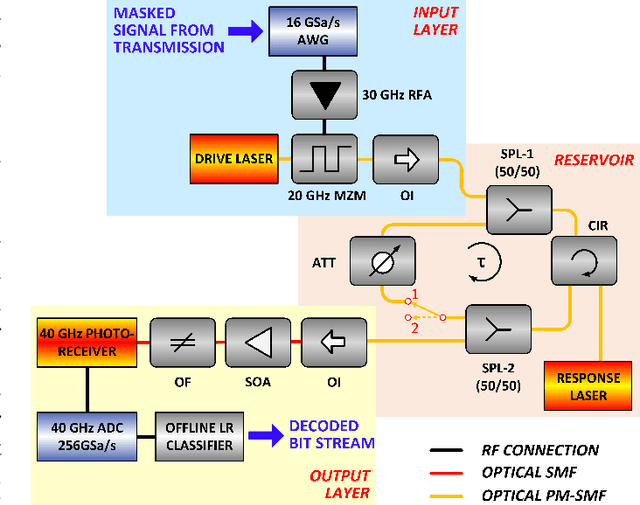
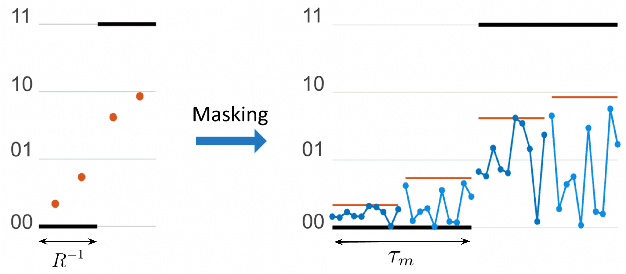
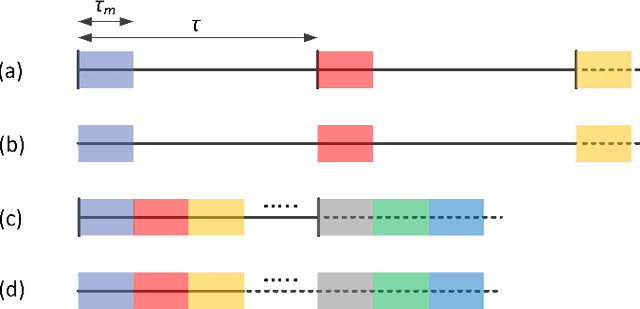
Abstract:Analog photonic computing has been proposed and tested in recent years as an alternative approach for data recovery in fiber transmission systems. Photonic reservoir computing, performing nonlinear transformations of the transmitted signals and exhibiting internal fading memory, has been found advantageous for this kind of processing. In this work, we show that the effectiveness of the internal fading memory depends significantly on the properties of the signal to be processed. Specifically, we demonstrate two experimental photonic post-processing schemes for a 56 GBaud PAM-4 experimental transmission system, with 100 km uncompensated standard single-mode fiber and direct detection. We show that, for transmission systems with significant chromatic dispersion, the contribution of a photonic reservoir's fading memory to the computational performance is limited. In a comparison between the data recovery performances between a reservoir computing and an extreme learning machine fiber-based configuration, we find that both offer equivalent data recovery. The extreme learning machine approach eliminates the necessity of external recurrent connectivity, which simplifies the system and increases the computation speed. Error-free data recovery is experimentally demonstrated for an optical signal to noise ratio above 30 dB, outperforming an implementation of a Kramers-Kronig receiver in the digital domain.
Robust High Dimensional Expectation Maximization Algorithm via Trimmed Hard Thresholding
Oct 19, 2020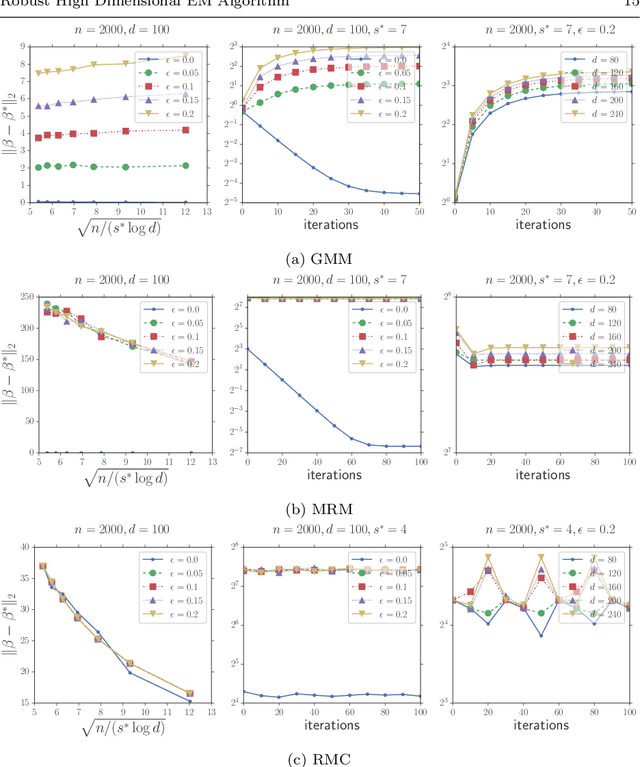
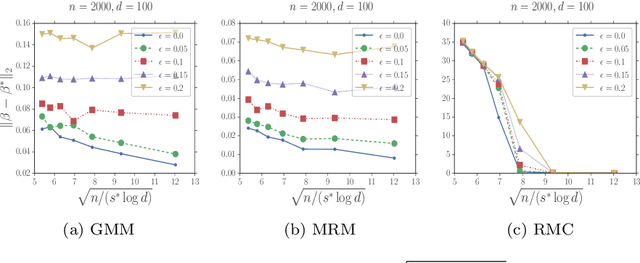
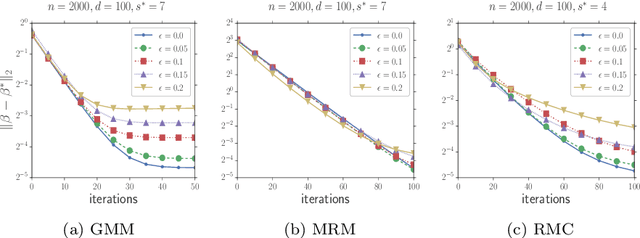
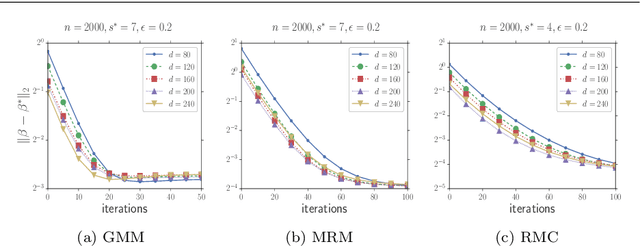
Abstract:In this paper, we study the problem of estimating latent variable models with arbitrarily corrupted samples in high dimensional space ({\em i.e.,} $d\gg n$) where the underlying parameter is assumed to be sparse. Specifically, we propose a method called Trimmed (Gradient) Expectation Maximization which adds a trimming gradients step and a hard thresholding step to the Expectation step (E-step) and the Maximization step (M-step), respectively. We show that under some mild assumptions and with an appropriate initialization, the algorithm is corruption-proofing and converges to the (near) optimal statistical rate geometrically when the fraction of the corrupted samples $\epsilon$ is bounded by $ \tilde{O}(\frac{1}{\sqrt{n}})$. Moreover, we apply our general framework to three canonical models: mixture of Gaussians, mixture of regressions and linear regression with missing covariates. Our theory is supported by thorough numerical results.
 Add to Chrome
Add to Chrome Add to Firefox
Add to Firefox Add to Edge
Add to Edge